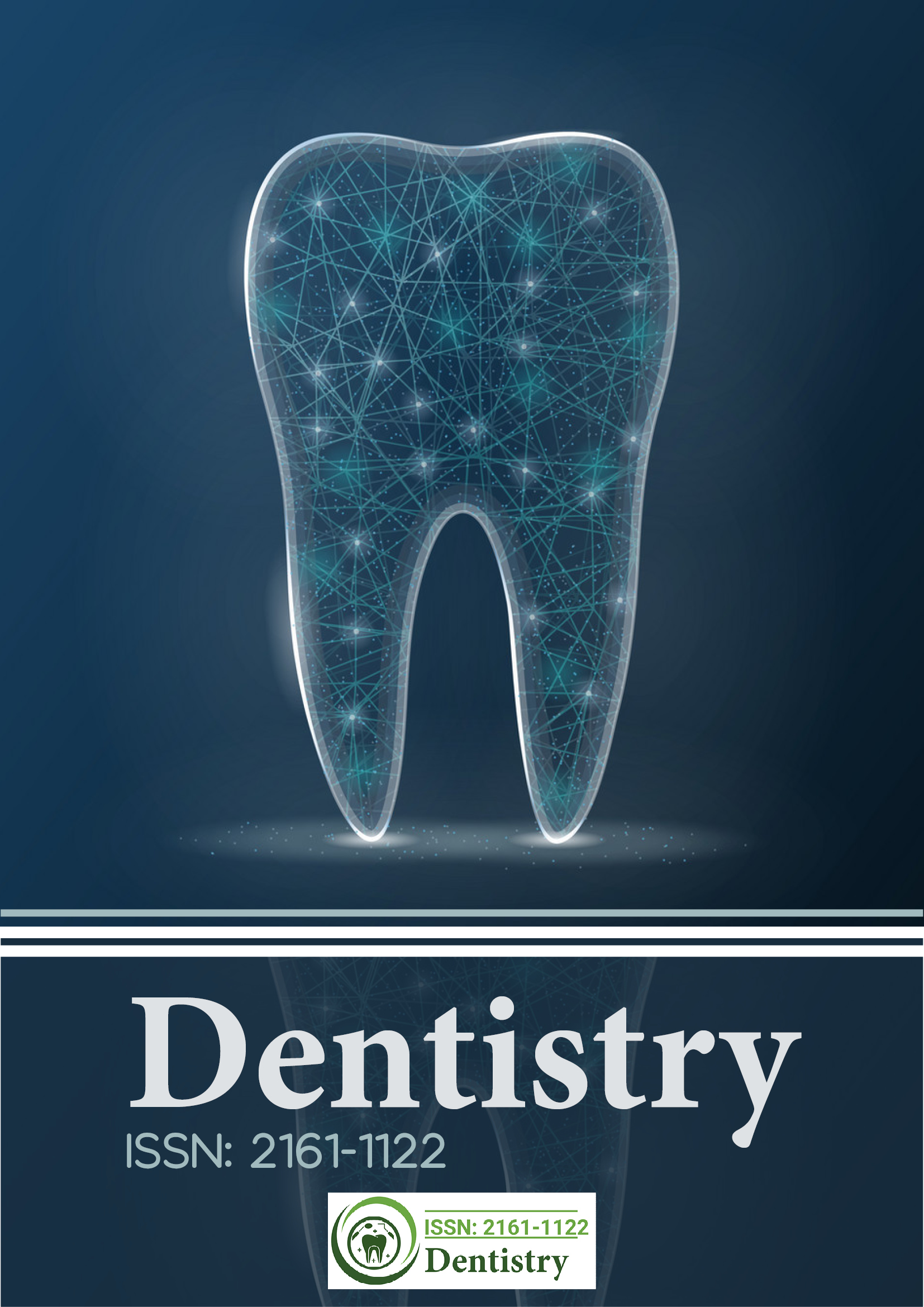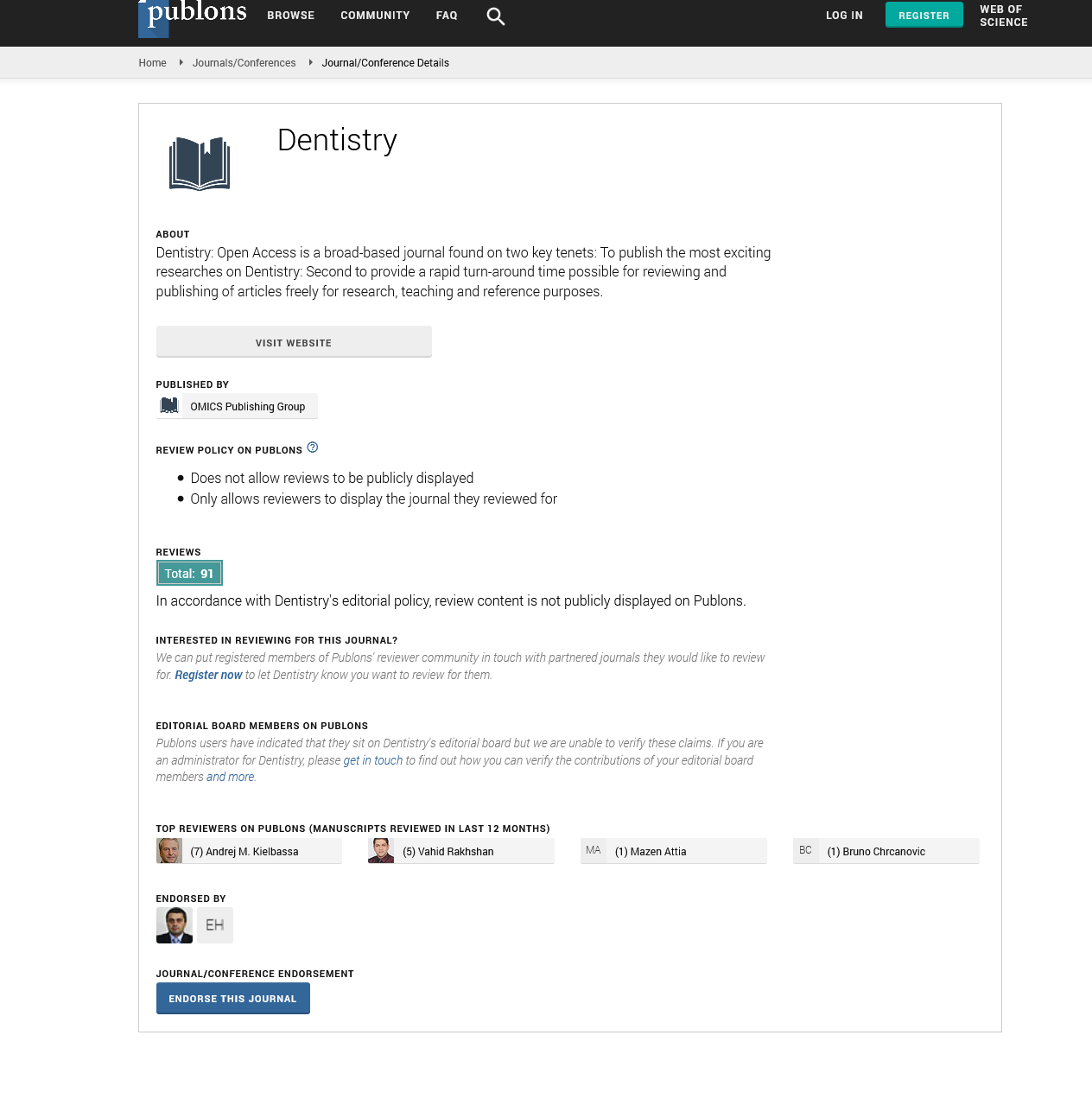Citations : 2345
Dentistry received 2345 citations as per Google Scholar report
Indexed In
- Genamics JournalSeek
- JournalTOCs
- CiteFactor
- Ulrich's Periodicals Directory
- RefSeek
- Hamdard University
- EBSCO A-Z
- Directory of Abstract Indexing for Journals
- OCLC- WorldCat
- Publons
- Geneva Foundation for Medical Education and Research
- Euro Pub
- Google Scholar
Useful Links
Share This Page
Journal Flyer

Open Access Journals
- Agri and Aquaculture
- Biochemistry
- Bioinformatics & Systems Biology
- Business & Management
- Chemistry
- Clinical Sciences
- Engineering
- Food & Nutrition
- General Science
- Genetics & Molecular Biology
- Immunology & Microbiology
- Medical Sciences
- Neuroscience & Psychology
- Nursing & Health Care
- Pharmaceutical Sciences
Commentary - (2024) Volume 14, Issue 2
Role of Dental Sealants in Cavity Prevention in Dentistry
Hissa Weam*Received: 03-Jun-2024, Manuscript No. DCR-24-26155; Editor assigned: 05-Jun-2024, Pre QC No. DCR-24-26155 (PQ); Reviewed: 19-Jun-2024, QC No. DCR-24-26155; Revised: 26-Jun-2024, Manuscript No. DCR-24-26155 (R); Published: 03-Jul-2024, DOI: 10.35248/2161-1122.23.14.685
Description
Dental sealants have emerged as a significant innovation in the field of preventive dentistry, providing an effective barrier against tooth decay and cavities. As a non-invasive and straight forward procedure, the application of dental sealants is primarily aimed at protecting the clot surfaces of the teeth, particularly the molars and premolars, which are prone to developing cavities. It explores the importance, mechanism, application process, benefits, and considerations associated with dental sealants in the prevention of cavities. Dental sealants are thin, plastic coatings applied to the chewing surfaces of the back teeth. The primary function of these sealants is to create a protective over the enamel of each tooth, effectively blocking out food particles and bacteria that can lead to decay. The clot surfaces of molars and premolars have deep grooves and pits that are difficult to clean thoroughly with regular brushing and flossing. These areas are particularly open to sign accumulation and subsequent decay, making them ideal candidates for sealant application. The application of dental sealants involves a relatively simple process that can be completed during a routine dental visit.
First, the teeth to be sealed are cleaned thoroughly to remove any fragments and plaque. Next, an acid etching gel is applied to the chewing surfaces to create a rough texture, which helps the sealant bond effectively to the tooth. After rinsing off the etching gel and drying the tooth, the sealant material is painted onto the enamel surface. A preserving light is then used to harden the sealant, forming a protective layer that can last several years. The primary benefit of dental sealants is their ability to prevent cavities. By providing a physical barrier on the tooth surface, sealants prevent food particles and bacteria from settling into the grooves and pits of the teeth, where they can cause decay. Studies have shown that dental sealants can reduce the risk of cavities in molars by nearly eighty percent, making them a highly effective preventive measure.
In addition to their cavity-preventing properties, dental sealants offer other significant advantages. They are cost-effective, especially when compared to the potential costs associated with treating cavities and other dental issues. The procedure is quick, painless, and non-invasive, making it an excellent option for children and adults alike. Furthermore, sealants can be applied without the need for anesthesia or drilling, which can be particularly beneficial for patients with dental anxiety. While dental sealants can be beneficial for individuals of all ages, they are particularly recommended for children and adolescents. The first and second molars typically emerge between the ages of six and fourteen, and these teeth are especially susceptible to decay. Applying sealants soon after the eruption of these molars can provide long-term protection during the years when children are most weak to cavities. Pediatric dentists often highlight the importance of early sealant application as part of a comprehensive preventive dental care organization. By protecting the newly permanent teeth, sealants help to ensure that children maintain healthy teeth into adulthood. This preventive approach can significantly reduce the incidence of cavities and the need for restorative treatments, promoting better oral health outcomes.
While children and adolescents are the primary candidates for dental sealants, adults can also benefit from this preventive measure. Adults who have deep grooves and pits in their teeth, or who are at high risk for cavities, can consider sealant application as part of their dental care routine. Additionally, adults who did not receive sealants during childhood and have experienced frequent cavities might find sealants to be an effective solution for preventing further decay. Despite their effectiveness, dental sealants are not without limitations. One important consideration is the longevity of the sealant. While sealants can last for several years, they are subject to wear and tear and may need to be reapplied periodically. Regular dental check-ups are essential to monitor the condition of the sealants and ensure they continue to provide adequate protection. Another consideration is the possibility of sealant failure. Improper application, contamination during the procedure, or failure to bond correctly to the tooth can lead to sealant failure, allowing decay to develop underneath the sealant. This underscores the importance of having the procedure performed by a skilled dental professional who can ensure proper application and maintenance.
Dental sealants are not a substitute for good oral hygiene practices. Patients with sealants should continue to brush and floss regularly and maintain a healthy diet to support overall dental health. Sealants should be viewed as a supplementary preventive measure rather than a replacement for routine dental care. The field of dental sealants is continually evolving, with ongoing research focused on improving the materials and techniques used in the application process. Innovations such as antimicrobial sealants, which incorporate agents that actively fight bacteria, and long lasting sealants are being developed to enhance the use and strength of this preventive measure. Additionally, increased awareness and education about the benefits of dental sealants are essential for promoting their use. Public health initiatives and dental education programs can play a significant role in encouraging more widespread adoption of sealants, particularly in underserved communities where access to dental care may be incomplete.
Citation: Weam H (2024) Role of Dental Sealants in Cavity Prevention in Dentistry. J Dentistry. 14:685.
Copyright: © 2024 Weam H. This is an open access article distributed under the terms of the Creative Commons Attribution License, which permits unrestricted use, distribution, and reproduction in any medium, provided the original author and source are credited.

